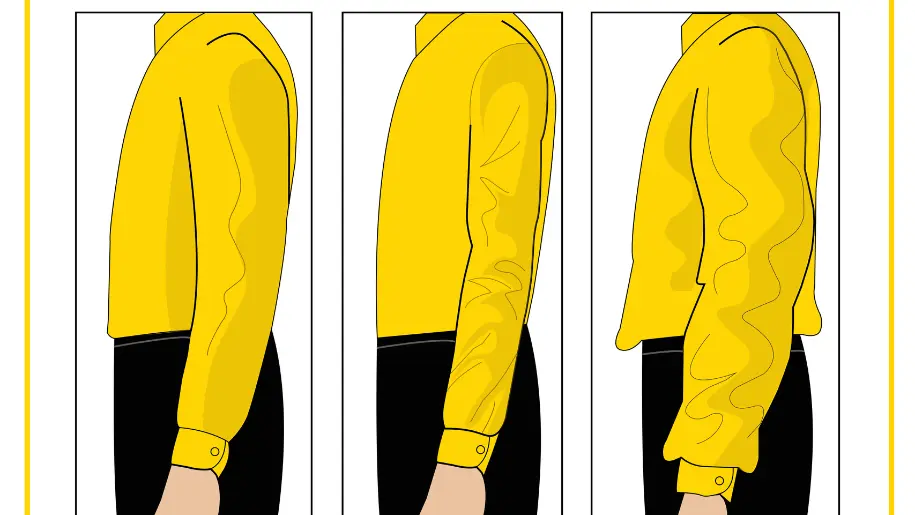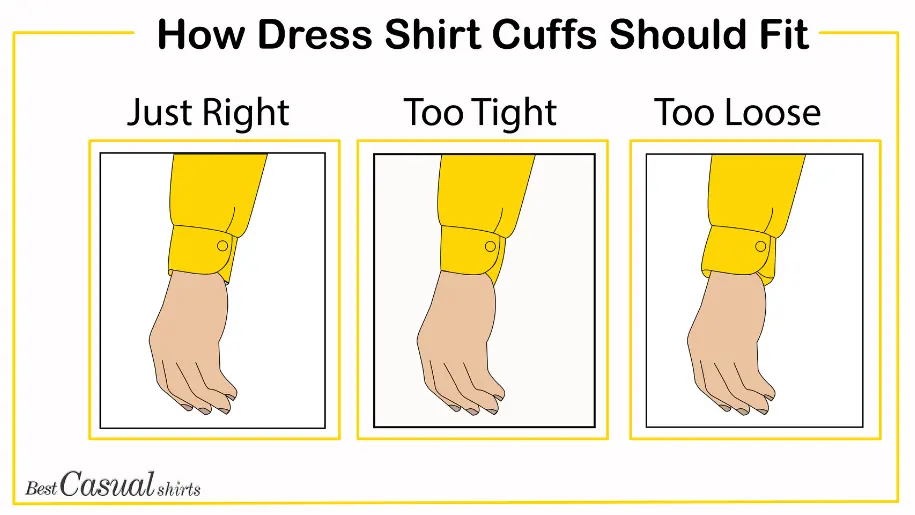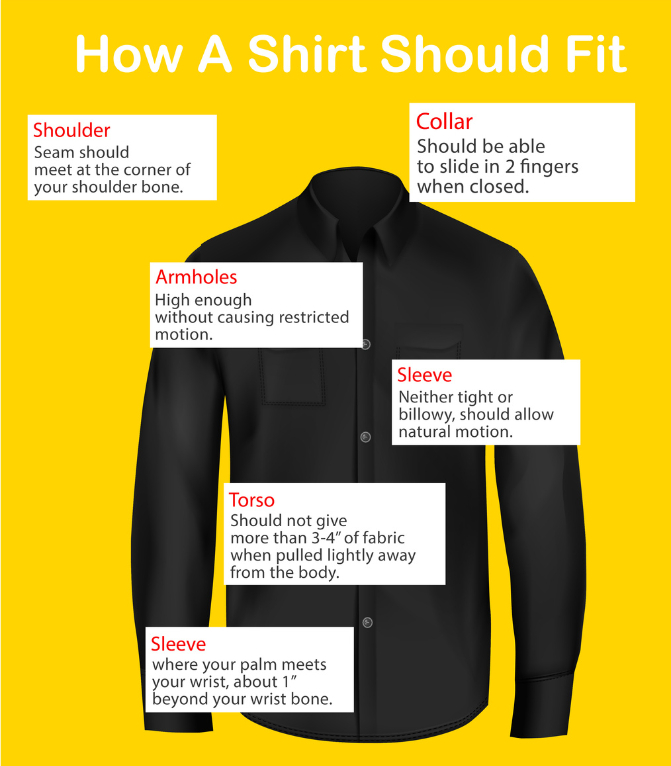Ever stood in front of a mirror, tugging at a shirt that feels more like a parachute? Or maybe you’ve felt like you’re wrapped in a straitjacket instead of a dress shirt?
Oh, the joys of fashion misadventures! Now, you might be wondering, “Is there a secret formula to this dress shirt dilemma?” Well, you’re in luck.
Together, I’ll dive into the nitty-gritty of finding that impeccable fit.

Because, let’s face it, a well-fitted dress shirt can be the difference between “Who’s that?” and “Who’s that?!”
Here’s a little tidbit to chew on: did you know that 70% of people admit to owning clothes they’ve never worn because of fit issues? Yikes!
So, buckle up, because I’m about to spill the beans on ensuring your dress shirt fits just right, making you the talk of the town.
The Nuances of Dress Shirt Fits

Beyond the standard slim, regular, and relaxed fits, there are other variations to consider:
- Classic Fit: Traditional with more room in the chest and waist, ideal for those who prioritize comfort.
- Modern Fit: A middle ground between slim and classic, offering a slightly tapered look without being too restrictive.
- Skinny Fit: The most form-fitting, best suited for those with a slender build.
The Historical Evolution of the Dress Shirt
From their humble beginnings as medieval undergarments to their status as symbols of elegance in the modern era, dress shirts have undergone significant transformations.
Their fit, style, and design have been shaped by cultural shifts, technological advancements, and evolving fashion trends.
This journey through time not only enriches our understanding of dress shirts but also underscores their timeless appeal.
Expert Tips on Achieving the Perfect Fit
- Collar: The collar should sit comfortably around your neck without feeling too tight. You should be able to slide two fingers between your neck and the collar easily.
- Shoulders: The shoulder seams should align perfectly with the edge of your shoulders. Any overhang or shortfall can disrupt the shirt’s overall look.
- Sleeves: The sleeves should end right at the base of your thumb. Too long, and they’ll bunch up; too short, and they’ll look awkward.
- Body/Waist: The shirt should taper slightly from the chest to the waist, following the contours of your body without being too tight.
- Length: The shirt should be long enough to tuck into your pants comfortably but not so long that it bunches up.
How Should A Dress Shirt Fit?
Collar Fitting
The first and most important thing to consider is how should a dress shirt collar fit.

The collar should sit comfortably around your neck without being too tight or too loose.
You should be able to slip two fingers between the collar and your neck with ease.
If you can’t, it’s too tight. And if there’s more than an inch of space, it’s too loose.
The ideal fit is somewhere in between those two extremes.
The collar should not pull against your neck.
If a dress shirt’s collar feels too tight when you put it on and take it off, then that means that there is too much tension on your neck muscles and therefore on your head.
This can cause headaches or even migraines if left unchecked long enough—especially for those who are prone to migraines!
Shoulder Fit
The shoulders of the shirt should sit comfortably on your shoulders without being too tight or too loose.

You shouldn’t feel like the fabric is pulling or that the shoulder seams are digging into your skin.
The best way to test shoulder fit is to raise your arms up and see how the shirt moves with you.
If it feels constricting, it’s too tight. And if it feels like it’s falling off your shoulders, it’s too loose.
The shoulders of the shirt should fit and not be too tight or too loose.
This is especially important when it comes to dressing shirts, as they are meant to be worn as part of an outfit that includes trousers, dress pants, and other garments.
If you have a coat with shoulder pads, it may be more comfortable if you wear your dress shirt with those pads in place instead of having them sewn into your shirt collar.
Sleeves Length
Another important factor to consider for men wearing dress shirts is the sleeve length.

You don’t want the sleeves to be so long that they’re bunching up at your wrists, but you also don’t want them to be so short that they’re showing off your arms.
The best way to find the right sleeve length is to try on the shirt and see how it looks.
If the shirt sleeves are too long, you can always have them altered.
You can’t fix them if they’re too short.
The sleeves of the shirt should end at the base of your wrist with a half inch or so to spare.
You should be able to roll up your fitted dress shirt sleeves without having them get caught on anything and pull them down or out of place.
Related:
Best Long Sleeve Shirts
Cuff Fit
They should be snug enough that they’re not falling off your wrists but not so tight that they’re cutting into your skin.

The best way to test cuff fit is to try on the sleeve cuff and then put your hands through the sleeves.
If you can move your hands and arms freely, then the cuff size is probably just right.
But if you feel like the fabric is constricting your movement, it’s a bit tighter.
And if the cuff feels loose and like it’s going to fall off, it’s too loose.
The cuff of a man’s dress shirt should leave a half-inch of the room when buttoned.
If it doesn’t, then you’re either wearing an undershirt with an incorrect size or your shirt is too large for your body.
The cuffs will often be narrower than other parts of the shirt and may have more padding in them so that they can stretch over wider shoulders.
But this does not necessarily mean that they should be wider than other parts of the garment: if there’s too much fabric around your wrists,
then it’ll feel tight against them and might cause irritation from wearing something too tight against sensitive skin surfaces all day long,
not to mention potentially causing discomfort if these areas become raw after long periods of wearing them without proper care.
Torso Fit (Chest & Waist)
The shirt should also fit comfortably around your chest width without being too tight or too loose.
You want there to be enough room so that you can breathe easily, but you don’t want the fabric to be so baggy that it’s unflattering.
A good way to test chest fit is to button up the shirt and then put your hand inside.
If you can’t slip your hand in with ease, it’s too tight.
And if there’s a lot of extra fabric, it’s too loose.
When you’re buttoning a dress shirt, there shouldn’t be any pulling in the chest area.
That’s because this is where your buttons are located: on the inside of each sleeve and on top of the shirt collar.
When you’re wearing a dress shirt for work or an important occasion, it’s important that all of your buttons including the collar button are able to complete their function without causing discomfort or irritation.
If they do become loose over time, let them fall naturally so they don’t get stuck in tight spots.

You don’t want the shirt to be so tight that it’s hugging your body, but you also don’t want it to be so loose that it looks like a tent on you.
The best way to find the right waist fit is to put on the shirt and then tuck it in.
If the fabric pulls or feels constricting, it’s too tight.
And if there’s excess fabric around your waist, it’s too loose.
Again, you want the fit to be somewhere in between those two extremes.
Ensure that the shirt is laid flat around your waist.
To ensure that the shirt fits properly, you should be able to fit two fingers between your body and the fitted shirt.
This will make sure that there are no gaps around your waist or chest area.
If the shirt is too tight or loose, it can cause discomfort in these areas as well as pull on other parts of your body by its own weight (i.e., pulling on your neck).
When shopping for a dress shirt, look for one with a fuller fit; this will give you more room to move around without feeling constricted by an ill-fitting garment!
Shirt Length
The last thing to consider is shirt length.

You don’t want the shirt to be so long that it’s bunching up at your waist or so short that it’s showing off your stomach or belt line.
The best way to find the perfect length is to try on the shirt and see how it looks.
If the shirt is too long, you can always have it altered.
But if it’s too short, there’s not much you can do to find the correct fit.
Tailor Fit
Once you’ve found a dress shirt size that fits well in all the important areas, it’s time to get it tailored.

This is where you can really fine-tune the fit to make sure the shirt looks great on your body.
A good tailor will be able to take in the sides of the shirt to give you a more slimming look,
shorten the sleeves to hit just the right spot on your arms, and adjust the waist so that it sits perfectly on your body.
Addressing Body Asymmetries
Each individual’s body is unique, with its quirks and variations. Some might have broader shoulders, while others might have a slightly tilted waist.
Recognizing these asymmetries and choosing a shirt that complements them is key. Tailoring can be an invaluable solution for these specific needs.
The Bottom Line
When you’re purchasing a dress shirt, it’s important to take all these things into consideration.
The perfect dress shirt should fit comfortably around your neck, shoulders, chest, and waist.
It should also be the right length in both the sleeves and the torso.
And finally, it should be appropriate for the occasion you’re wearing it to.
With a little bit of effort, you can find a shirt that looks great and feels comfortable.
Just keep this style advice in mind and you’ll be sure to find the classic fit!
We value your feedback! If you have any questions or need further clarification on any points, please leave a comment below. Your insights can help us refine our content and address any areas of confusion.
Frequently Asked Questions
How do you know if a dress shirt is too big?
There are a few telltale signs. If the fabric is bunched up around your stomach or if the shirt hangs down past your thighs, it’s probably too big. Also, if you can’t button the shirt all the way up or if the shirt sleeves are so long that they’re bunching up at your wrists, it’s time to size down to a custom shirt.
How do you know if a dress shirt is too small?
There are a few signs to look out for. If the fabric is stretched tight across your chest or if you can’t comfortably move your arms, it’s probably too small. Also, if the shirt pulls at your buttons or feels constricting in any way, it’s time to size up to have custom shirts.
How should a dress shirt fit arms?
Dress shirts should fit comfortably around the arms, with enough room to allow for easy movement. The sleeves should be long enough to reach the wrist, but not so long that they bunch up when the arms are bent. The shirt should also fit snugly around the chest and shoulders, without being so tight that it restricts breathing or movement. When trying on a slim-fit shirt, it is important to keep these factors in mind in order to ensure a comfortable and flattering fit.
How long should a dress shirt fit?
The shirt should hit at or just below the belt, and the sleeves should be long enough to show about half an inch of your cuff. If the shirt is too long or too short, it will throw off the proportions of your outfit and make you look unbalanced. And if the sleeves are too long or too short, they’ll bunch up and look awkward.
How tight should the dress shirt cuff be?
The cuff should be snug but not too tight. You should be able to comfortably put your hand through the cuff, but it shouldn’t be so loose that it’s falling off your wrist.
How should a dress shirt feel around the neck?
The neck of the shirt should fit snugly around your neck, with just enough room to comfortably button the collar. If it’s too loose, you’ll look like you’re swimming in the shirt. And if it’s too tight, you’ll feel constricted and uncomfortable.

![What Color Pants With Black Shirt – Style Guide [2024]](https://bestcasualshirts.com/wp-content/uploads/2023/12/What-Color-Pants-With-Black-Shirt-450x254.png)






